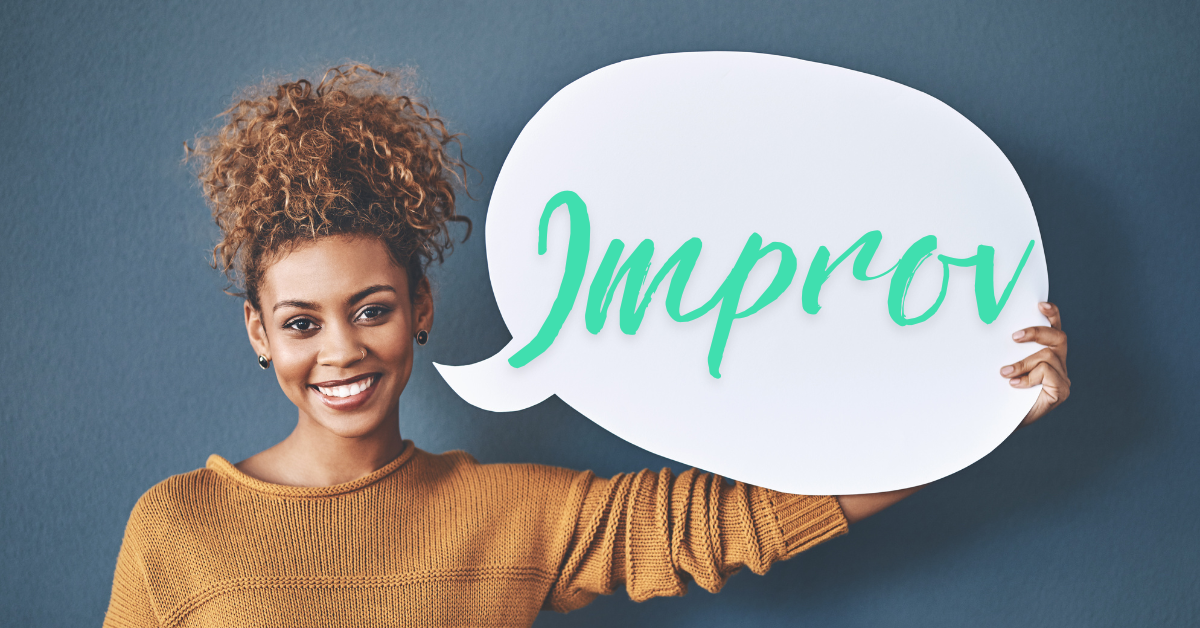Public speaking can be daunting, but with the right techniques, anyone can master the art. One powerful tool to enhance your public speaking skills is improvisation. Improv, known for its spontaneity and creativity, can significantly boost your confidence and engagement with the audience. In this blog post, you'll learn improv techniques to improve public speaking skills, like exercises and games that will help you become a more dynamic and effective speaker.
The Benefits of Improv for Public Speaking
Improvisation offers numerous benefits for public speaking, including:
- Enhancing Quick Thinking and Adaptability: Improv trains you to think on your feet, making you more adaptable to unexpected situations.
- Building Confidence and Reducing Anxiety: Regular practice of improv reduces the fear of public speaking by making you comfortable with uncertainty.
- Encouraging Creativity and Engagement: Improv encourages a playful and creative approach, which helps keep your audience engaged.
- Improving Listening and Observational Skills: Effective improv requires attentive listening and observation, crucial skills for responding to your audience.
Famous Improv Comedians and Their Techniques
Tina Fey: "Yes, And"
Tina Fey’s “Yes, And” technique is a cornerstone of improv. It involves accepting what another person says (“Yes”) and then adding to it (“And”). This method helps build on ideas collaboratively and keeps the conversation flowing. To learn the specific rules of improvisation by Tina Fey, click here.
Stephen Colbert: Embracing Vulnerability
Stephen Colbert emphasizes the importance of embracing vulnerability and authenticity. Being genuine and open on stage creates a strong connection with your audience. In his book, Stephen Colbert's Midnight Confessions, Colbert says, "By embracing self-acceptance, vulnerability, and growth, while fostering laughter, practicing self-care, and finding joy in the little things, we can embark on a fulfilling journey towards personal growth and a more meaningful existence."
Amy Poehler: Collaborative Creativity
Amy Poehler’s approach to improv highlights the importance of supporting your fellow performers. This collaborative creativity ensures that everyone shines and the performance is cohesive. Amy says, "You can’t do it alone. … As you navigate through the rest of your life, be open to collaboration. Other people and other people’s ideas are often better than your own. Find a group of people who challenge and inspire you, spend a lot of time with them, and it will change your life."
Whose Line is It Anyway?
An American improvisational comedy television series, Whose Line is it Anyway?, originally aired in 1998 and has had 13 seasons with the latest episode airing in January 2024 at the time of this blog post. The show consists of a panel of four performers who create characters, scenes, and songs on the spot, in the style of short-form improvisation games. Watch to gain ideas for lots of improv games. By the way, the show is amazing!
Key Improv Exercises for Public Speaking
1. "Yes, And" Game
Description: Participants build on each other’s statements with “Yes, and…” See rules here.
Benefits: Enhances quick thinking and collaboration.
Application: Use this technique to build on audience questions and comments.
2. Word Association
Description: Participants quickly respond with the first word that comes to mind. See list of 16 word games here.
Benefits: Reduces hesitation and encourages quick thinking.
Application: Enhance vocabulary and generate ideas swiftly.
3. Storytelling Circle
Description: Each person adds a sentence to a developing story.
Benefits: Improves structuring and creativity in speech.
Application: Create engaging narratives spontaneously.
4. Character Switch
Description: Participants switch characters and respond from different perspectives. Create 3 to 5 characters and the scene and then have people switch characters.
Benefits: Explores different styles, perspectives, and sponteneity.
Application: Adapt to various audience reactions and moods.
5. Gibberish Translation
Description: One person speaks in gibberish, another translates. The translator makes up a story based on the gibberish speaker's body language, tone, inflection, and facial expression.
Benefits: Enhances non-verbal communication and body language.
Application: Express ideas clearly without over-relying on words.
Incorporating Improv into Your Practice
- Daily Routine: Integrate these exercises into your daily practice.
- Workshops: Join improv workshops or groups for more structured learning.
- Consistency: Practice regularly to see continuous improvement.
Real-Life Examples and Success Stories
Many professionals have transformed their public speaking abilities through improv. For instance, entrepreneurs and business leaders have reported increased confidence and engagement after incorporating improv techniques into their routines.
Conclusion
Improvisational techniques are a fun and effective way to improve your public speaking skills. Try out these exercises, and you’ll soon notice the benefits. Share your experiences with improv and public speaking in the comments below!
References and Further Reading
- "Bossypants" by Tina Fey
- "I Am America (And So Can You!)" by Stephen Colbert
- "Yes Please" by Amy Poehler
- Local improv workshops and online resources

